Fascin is a key regulator of breast cancer invasion that acts via the modification of metastasis-associated molecules
- PMID: 22076152
- PMCID: PMC3208623
- DOI: 10.1371/journal.pone.0027339
Fascin is a key regulator of breast cancer invasion that acts via the modification of metastasis-associated molecules
Abstract
The actin-bundling protein, fascin, is a member of the cytoskeletal protein family that has restricted expression in specialized normal cells. However, many studies have reported the induction of this protein in various transformed cells including breast cancer cells. While the role of fascin in the regulation of breast cancer cell migration has been previously shown, the underlying molecular mechanism remained poorly defined. We have used variety of immunological and functional assays to study whether fascin regulates breast cancer metastasis-associated molecules. In this report we found a direct relationship between fascin expression in breast cancer patients and; metastasis and shorter disease-free survival. Most importantly, in vitro interference with fascin expression by loss or gain of function demonstrates a central role for this protein in regulating the cell morphology, migration and invasion potential. Our results show that fascin regulation of invasion is mediated via modulating several metastasis-associated genes. We show for the first time that fascin down-regulates the expression and nuclear translocation of a key metastasis suppressor protein known as breast cancer metastasis suppressor-1 (BRMS1). In addition, fascin up-regulates NF-kappa B activity, which is essential for metastasis. Importantly, fascin up-regulates other proteins that are known to be critical for the execution of metastasis such as urokinase-type plasminogen activator (uPA) and the matrix metalloproteases (MMP)-2 and MMP-9. This study demonstrates that fascin expression in breast cancer cells establishes a gene expression profile consistent with metastatic tumors and offers a potential therapeutic intervention in metastatic breast cancer treatment through fascin targeting.
Conflict of interest statement
Figures
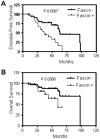
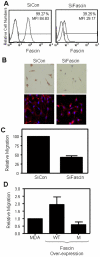
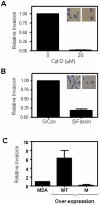
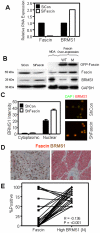
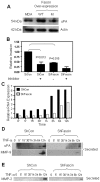
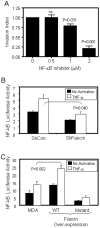
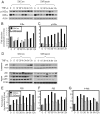
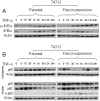
Similar articles
-
Non-thermal atmospheric pressure plasma inhibits thyroid papillary cancer cell invasion via cytoskeletal modulation, altered MMP-2/-9/uPA activity.PLoS One. 2014 Mar 25;9(3):e92198. doi: 10.1371/journal.pone.0092198. eCollection 2014. PLoS One. 2014. PMID: 24667444 Free PMC article.
-
Signal transducers and activators of transcription 3 (STAT3) directly regulates cytokine-induced fascin expression and is required for breast cancer cell migration.J Biol Chem. 2011 Nov 11;286(45):38886-93. doi: 10.1074/jbc.M111.286245. Epub 2011 Sep 20. J Biol Chem. 2011. PMID: 21937440 Free PMC article.
-
Leucine aminopeptidase 3 promotes migration and invasion of breast cancer cells through upregulation of fascin and matrix metalloproteinases-2/9 expression.J Cell Biochem. 2019 Mar;120(3):3611-3620. doi: 10.1002/jcb.27638. Epub 2018 Nov 11. J Cell Biochem. 2019. PMID: 30417585
-
How does fascin promote cancer metastasis?FEBS J. 2021 Mar;288(5):1434-1446. doi: 10.1111/febs.15484. Epub 2020 Jul 23. FEBS J. 2021. PMID: 32657526 Free PMC article. Review.
-
Fascin: a key regulator of cytoskeletal dynamics.Int J Biochem Cell Biol. 2010 Oct;42(10):1614-7. doi: 10.1016/j.biocel.2010.06.019. Epub 2010 Jun 30. Int J Biochem Cell Biol. 2010. PMID: 20601080 Review.
Cited by
-
Comparative Analysis of Breast Cancer Metabolomes Highlights Fascin's Central Role in Regulating Key Pathways Related to Disease Progression.Int J Mol Sci. 2024 Jul 18;25(14):7891. doi: 10.3390/ijms25147891. Int J Mol Sci. 2024. PMID: 39063133 Free PMC article.
-
Extracellular vesicles produced in B cells deliver tumor suppressor miR-335 to breast cancer cells disrupting oncogenic programming in vitro and in vivo.Sci Rep. 2018 Dec 4;8(1):17581. doi: 10.1038/s41598-018-35968-2. Sci Rep. 2018. PMID: 30514916 Free PMC article.
-
SETD3 acts as a prognostic marker in breast cancer patients and modulates the viability and invasion of breast cancer cells.Sci Rep. 2020 Feb 10;10(1):2262. doi: 10.1038/s41598-020-59057-5. Sci Rep. 2020. PMID: 32042016 Free PMC article.
-
XIAP 3'-untranslated region as a ceRNA promotes FSCN1 function in inducing the progression of breast cancer by binding endogenous miR-29a-5p.Oncotarget. 2017 Mar 7;8(10):16784-16800. doi: 10.18632/oncotarget.15159. Oncotarget. 2017. PMID: 28186968 Free PMC article.
-
Migration and invasion induced by linoleic acid are mediated through fascin in MDA-MB-231 breast cancer cells.Mol Cell Biochem. 2018 Jun;443(1-2):1-10. doi: 10.1007/s11010-017-3205-8. Epub 2017 Oct 19. Mol Cell Biochem. 2018. PMID: 29052029
References
-
- Bashyam MD. Understanding cancer metastasis: an urgent need for using differential gene expression analysis. Cancer. 2002;94:1821–1829. - PubMed
-
- Chambers AF, Naumov GN, Varghese HJ, Nadkarni KV, MacDonald IC, et al. Critical steps in hematogenous metastasis: an overview. Surg Oncol Clin N Am. 2001;10:243–255, vii. - PubMed
-
- Fidler IJ. Seed and soil revisited: contribution of the organ microenvironment to cancer metastasis. Surg Oncol Clin N Am. 2001;10:257–269. vii-viiii. - PubMed
-
- Nicolson GL. Organ specificity of tumor metastasis: role of preferential adhesion, invasion and growth of malignant cells at specific secondary sites. Cancer Metastasis Rev. 1988;7:143–188. - PubMed
-
- Saaristo A, Karpanen T, Alitalo K. Mechanisms of angiogenesis and their use in the inhibition of tumor growth and metastasis. Oncogene. 2000;19:6122–6129. - PubMed
Publication types
MeSH terms
Substances
LinkOut - more resources
Full Text Sources
Other Literature Sources
Medical
Miscellaneous

